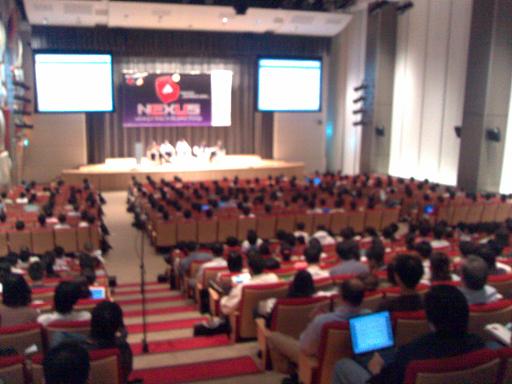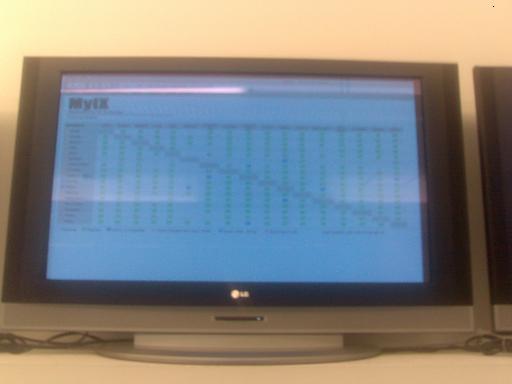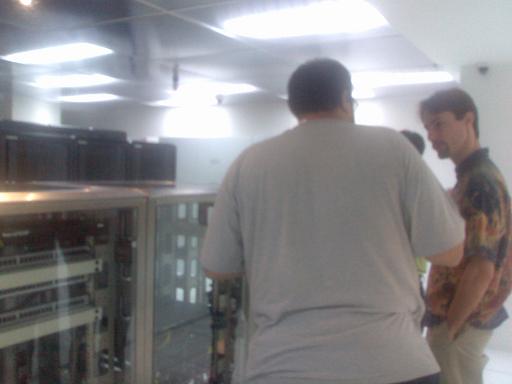March 27th, 2007
Google RSS Reader has being release for a while. I remember playing with it last year but it was slow and the UI, for lack of a better work, sucks.
Over the weekend, I decided to give it a try again. I was surprised to see a new face lift and a new UI among other new features they are adding to it. So I decided to give it another shot and imported my OPML into it.
And I love it! :-)
They got it this time definitely. I think it is time I chunk my offline RSS readers now.
Incidentally, Google Reader also comes with this feature to tag blog entries to be shared. Check out my shared list. (Yes, they need a shorter permalink :)
March 26th, 2007
When I was playing with Ruby on Rail, I thought this was really cool. An AJAX ruby interpreter running off the browser.
Then I saw this and I was blow off. DOS Emulator on Java. Anyway, if you miss those games from the 80s, go try it out :-)
March 25th, 2007

Nexus 2007 definitely exceed all our expectations. The folks at The Digital Movement certainly done a great job. Well done!
The session with the IT veterans/big shots was a great session by itself but really out of place with the rest of the sessions. The culture gap is very obvious.
And oh, Cory (of Secondlife) was definitely the star of the show. Everyone loves the talk he gives.
March 17th, 2007
MCMC (Malaysia) announced the winners of 2.3Ghz spectrum beauty contest:
Malaysia’s telecoms regulator has named four newcomers as winners of Wimax wireless high speed internet licences.
The winning bidders were Bizsurf Sdn Bhd, MIB Comm Sdn Bhd, Redtone-CNX Broadband Sdn Bhd and Asiaspace Dotcom Sdn Bhd.
I was involved in some way so I will not comment beyond giving my congratulations to the winners. :-)
March 3rd, 2007
 Went to visit MyIX today with Bill Woodcock. MyIX is the Malaysia Neutral Internet Exchange that was recently setup. Thanks for having us :-)
Went to visit MyIX today with Bill Woodcock. MyIX is the Malaysia Neutral Internet Exchange that was recently setup. Thanks for having us :-)
I have a lot of concerns over the setup but since I already relay my comments to friends involved in the project, I will not repeat them here. Regardless, MyIX is definitely a positive move to the right direction. In fact, Malaysia have done better than Singapore in this aspect.
* See my old article on Internet Peering in Singapore. Although written nearly 3 years ago, nothing much has changed. (And yes, I am aware of SOX).

February 28th, 2007
I didnt stay for the whole APRICOT 2007 this time as I am needed back in Singapore. On the other hand, the most useful meetings I get out of APRICOT are the side meetings that is usually held just before APRICOT 2007.
Anyway, here are some notes from APRICOT 2007.
1. I was surprised to hear that Area Sensor Network was a very hot topic in APAN. Maybe I need to pay a little attention.
2. ASN are running out (just like IPv4 address). RIRs already trying to get people to migrate from the 16 bits to the 32 bits ASN. Luckily, the transition is going to be as complex as IPv4 to IPv6.
3. For some unknown reasons, a lot of developing country are falling over themselves to host Internet Governance Forum.
4. Oh yea, Marc Blanchet, my co-chair of the IDN Working Group at IETF started his blog. :-)
I have my own thoughts on these issues but perhaps another day.
February 22nd, 2007
Last week, I attended Unconference organized by the local Entrepreneur27. Others like Kevin has covered the event so I won’t but I share some thoughts instead.
Unconference (and also BarCamp a few weeks before) is unique in many ways. It is close to what you get in the typical “cool” or “geek” event in the Silicon Valley. Very loose and informal, but always have great fun meeting people and listen to speakers talking about their thoughts, cool companies and what they are doing. This is a sharp contrast to the other tech conference in Singapore which is usually pretty boring.
More importantly, it is organized by grassroots and not by some in ivory tower up there thinking it is cool to have such event in Singapore. It is put together by students and recent graduates who sincerely believe that such event would be useful (and it is). Many of them spend a 12-18 months in Bay Area thanks to the EDB programme so they are trying to bring the culture back to Singapore.
Now, some may criticize that these events are badly organized or with weak content. While those are true to a certain extend, but bear in mind that these kind of events are non-existence in Singapore before. Regardless, I am sure (a) it will only get better and (b) there will always be complains, however well-run it is.
It is the first of many to come. And I am really glad to see this happening.
February 16th, 2007
This morning, I received an unsolicited request to link to a website. Normally, I just dump them aside but this is an exception. First, it is an article on dailywireless.com, a site that I read occasionally and second, it is a pretty good guide to securing wifi network.
How-to: Secure a Wireless LAN
By now you’ve renamed your Wifi so that hackers won’t see the default name as they sweep for unprotected Wifi setups. But wouldn’t it be even better if hackers and curious neighbors didn’t know you had a Wifi setup at all? Usually, your access point or router is programmed to broadcast the network name (SSID) over the air at regular intervals. While broadcasting is essential for businesses and mobile hotspots to let people find the network, it isn’t needed at home, so eliminate it.
January 7th, 2007
Alcatel, one of the major submarine cable builder in the world, has an interesting resource page on submarine cables like an animation on how to repair submarine cables cut. (via Ben Frankes)
The animation looks easy. Detect the cut, pick up one cable, then the other and then join them back. Even considering it takes time to find the cables, it normally dont take more than 48 hours to fixed the cut.
So what did it takes so long to fixed the cable at the recent cable cut with some estimates going up to nearly 3 weeks?
Well, in an earthquake, the cables are displaced from its original expected position. Not only the cables are displaced, earthquake also causes landslides, which means the cables may be potentially buried. In a massive earthquake, there could also be multiple cuts. Displaced, hidden with multiple cuts, locating the sever submarine cables is like finding needle in the haystack.
January 5th, 2007

Found this “comic” in the newspaper. It is more real then funny tho.






